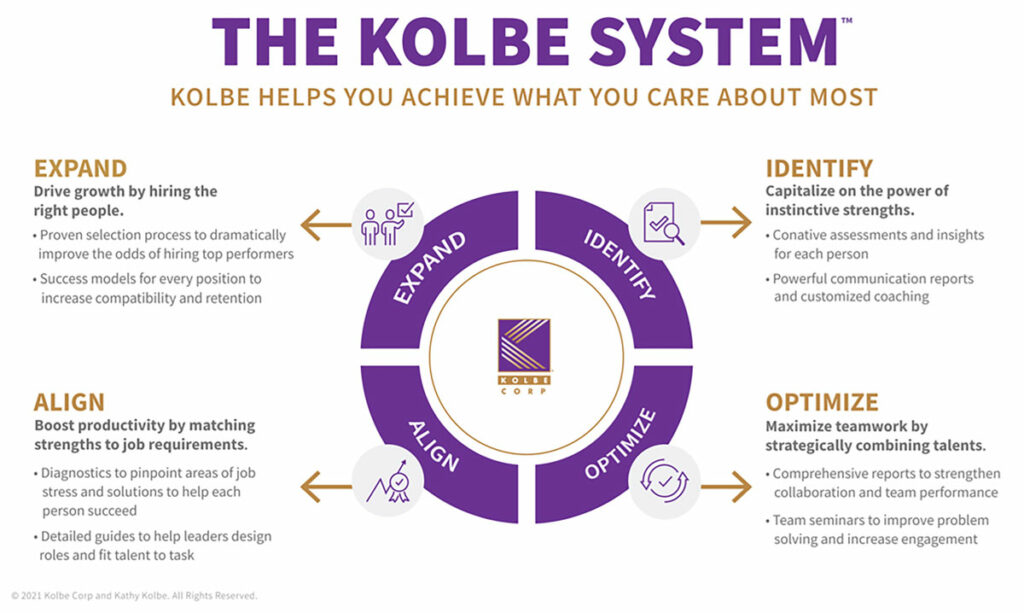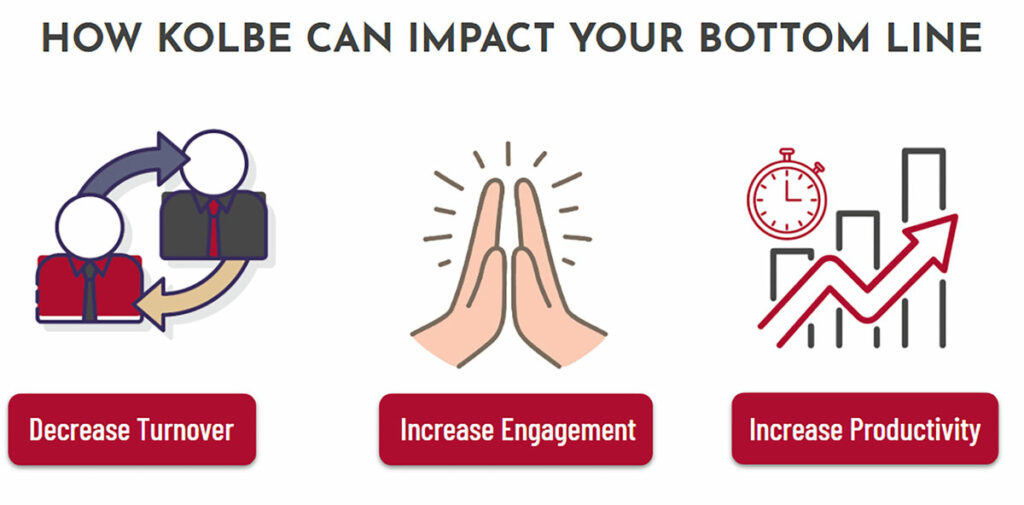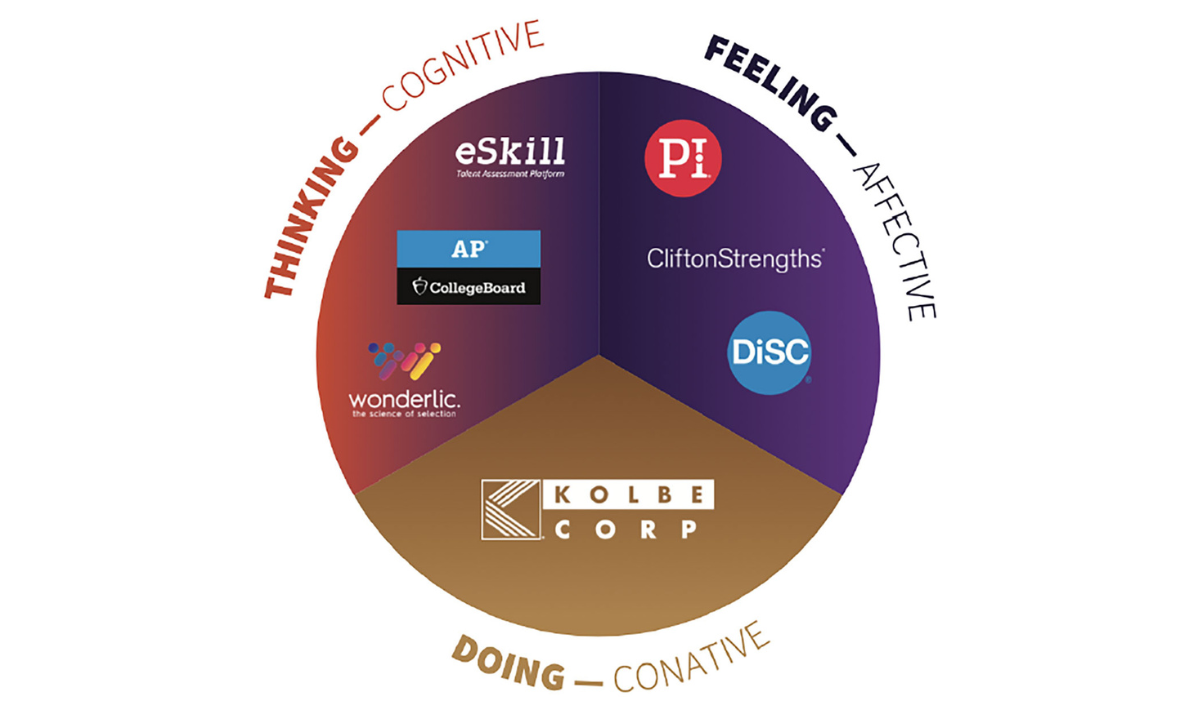Know yourself and your team through a helpful assessment process.
Typically, half of every dollar spent by a dental organization goes to its people. So, their personalities, their capabilities, and what motivates them is critical to know and understand as a leader.
Jess Pare is DEO’s leadership development coach and is certified in Kolbe. The Kolbe Certification gives knowledge and insight to identify people’s natural talents and help organizations utilize those talents productively. It’s focused on leveraging Kolbe solutions to solve real-world business problems.
Kolbe can be used in self-assessments, team hiring, and team engagement.
“Kolbe can be used in hiring because it’s been proven to be non-discriminatory,” said Emmet Scott, DEO Head Coach. “It can be used to open up your leadership capabilities and reduce the friction that happens.”
Kolbe can be used to change a situation from conflict to complimentary by using its data to understand why people are tackling a problem differently from each other.
“You start using the superpowers of your team to understand why they are prone to do certain activities and not others,” Scott said.
It’s the front desk dilemma. “You might have someone say, ‘sorry I haven’t gotten to all this paperwork because I’m answering all these phones,’ while someone else might say, ‘sorry I haven’t answered these phones because I have all this paperwork,” Scott explained.
“Their passion will drive them toward different things,” he added.
Going from clinician to entrepreneur to executive, you will learn how to move from your own boat into a boat with your team. Understanding yourself better will help you understand your team better.
“We’re assessed on the three parts of our mind,” Pare said. “There’s the thinking part and our cognitive abilities and intellect, and there’s the feeling part assessing motivations, preferences, personality, and values, and there’s the doing part or what we naturally do when we’re free to be ourselves and approach problem-solving.”
The thinking part of the mind, or cognitive part, includes IQ, skills, reason, knowledge, experience, and education; and the feeling part, or the affective part, includes desires, motivation, attitudes, preferences, emotions, and values. But Kolbe is the only assessment tool that tells us how we naturally approach problem-solving in the doing part of the mind.
The doing part, or the conative part, includes drive, instinct, necessity, mental energy, innate force, and talents.
“If you’re hiring a new team member or moving people around in your organization, you might be assessing them through a skills test or thinking assessment and interviewing them to gauge their personality, values and if they are a fit in your organization,” Pare said. “But you might not be measuring the doing part of their mind or how they naturally solve problems.”
But if you are, you can measure how their natural way of approaching the world is a match for what you need them to do every day. Because even if they are a match in education, skills, personality, and values, if they aren’t a match in problem-solving, they will get stressed and they will burn out faster.
“You put a lot of energy and investment into hiring the right person and you don’t want them burning out and having a lot of turnover because there’s a mismatch in the doing part of the mind,” Pare said.
The Kolbe assessment increases team engagement by reducing stress caused by a poor role fit because it’s about work behavior rather than communication style or personality. This allows you to divide responsibilities based on individuals’ strengths rather than their job titles. Kolbe can help decrease turnover, increase engagement, and increase productivity.
“Sometimes when someone’s doing something differently, we get very emotional about it,” Scott said. “Team members might start to talk about them.”
“But it goes back to people’s lives being bigger than your company. It’s not because they are a lazy or unwilling generation,” he added. “That’s easy to say but you don’t have an entire generation that is lazy. And you don’t have a lot of people trying to get into the dental industry saying, ‘I just don’t want to do this.’”
What’s the underlying issue? You might be misaligned with their passion, or they might feel like they are failing. So, it’s important to have tools to help office managers and team members approach these problems.
“Most have done the Kolbe and shared it as a team but haven’t engaged with it,” Scott said. “There are multiple Kolbe tests to assess every job description and figure out if it’s the right fit.”
According to Gallup, the key driver for a company’s stock increase is its earnings increase, and the key drive for earnings increase is revenue growth. But what drives revenue growth? Engaged customers. These customers actively promote your brand and come back repeatedly.
Engaged employees drive engaged customers, and employees are engaged if their strengths are aligned to their role. Kolbe has a systematic approach to helping you and your managers identify this exactly.
The Kolbe system is broken down into four buckets:
- Identify.
- Optimize.
- Align.
- Expand.
Identify. Capitalize on the power of instinctive strengths through conative assessments for each person, powerful communication reports, and customized coaching.
Optimize. Maximize teamwork by strategically combining talents through comprehensive reports strengthening collaboration and team performance with team seminars to improve problem-solving and increase engagement.
Align. Boost productivity by matching strengths to job requirements through diagnostics to pinpoint areas of job stress and solutions to help each person succeed with detailed guides to help leaders design roles and fit talent to task.
Expand. Drive growth by hiring the right people through a proven selection process to dramatically improve the odds of hiring top performers with success models for every position to increase compatibility and retention.
Identify: Kolbe A Index
The Kolbe A Index is the first assessment someone will take. They will get their results on a customized webpage and dive into understanding their M.O. or modus operandi – their natural pattern of behavior when free to be themselves to take purposeful action. Results are based on four continuums of instinct-based action modes:
- Fact Finder.
- Follow Thru.
- Quick Start.
- Implementor.
It shows where someone falls on each continuum. The fact finder is how they gather and share information, the follow thru is how they organize and design, the quick start is how they deal with risk and uncertainty, and the implementor is how they handle space and intangibles.
There are three zones of operation in each of the four continuums equaling 12 Kolbe Strengths and there are four strengths most natural for each of us.
“None of these strengths are better than the others,” Pare said. “None of these assessments are intended to be used to pigeonhole or blame anyone. As leaders, we need to know what our best strengths are so we can put ourselves in the best-fit role for ourselves and then delegate responsibilities to those who can really thrive and exceed our own performance in those areas.”
There are different strengths within each of the three zones of operation in each continuum.
“Don’t guess anyone else’s modus operandi,” Pare said.
| Four continuums of instinct-based action Fact Finder: How you gather and share information. Simplify • Distill information • See the big picture • Minimize investigation Explain • Edit the details • Fact check written materials • Work within the priorities Specify • Research in depth • Establish specific priorities • Develop complex strategies Follow Thru: How you organize and design. Adapt • Vary the approach • Create shortcuts • Loosen rigid processes Maintain • Adjust procedures • Identify inconsistencies • Maintain order Systematize • Create the plan • Organize information and materials • Bring focus and closure Quick Start: How you deal with risk and uncertainty. Stabilize • Minimize risk factors • Reduce the unexpected • Stick with what’s working Modify • Adjust to change • Sustain innovations • Check things out before trying them Innovate • Experiment and initiate change • Create a sense of urgency • Brainstorm possibilities Implementor: How you handle space and intangibles. Envision • Imagine solutions • Describe without having to demonstrate • Deal with work that is abstract/intangible Restore • Repair mechanical devices • Handle tangibles • Bridge the gap between physical and virtual solutions Demonstrate • Demonstrate physically • Build and handcraft tangible solutions • Maximize use of space |
Organize: Ideal team make up
When teams are well-balanced, they are collaborative.
Is your team working collaboratively together on a project or are they more distributed? Teams can operate differently like a team in a call center that can get their jobs done independent of each other versus a marketing team in a central office that has to rely on each other to accomplish their goals.
“We’re talking about the team that has to rely on each other and have that diversity of strength,” Pare said.
“Kathy Kolbe discovered through her work with gifted students that teams that work well with each other have 50% of the team in the middle zones of operation and 25% of the team was on either side of those middle zones,” she added.
Teams that don’t work well with each other might have too much of the same energy, not enough of any given strength or group conflict.
“Group conflict doesn’t mean you can’t work together,” Pare said. “You just need to be aware of each other’s differences. You might need to inject someone into the conversation who’s in the middle range to help translate.”
If your entire team has taken the Kolbe A, you can run a distribution to see your team’s strengths by percentage and Kolbe sends you a team success report. It tells you what’s great about your team, where your team might get stuck, and tips for maximizing productivity.
“This helps your team see its strengths and have self-awareness about where your team might get stuck,” Scott said. “But if this is your practice make up and it’s working, let’s just be honest about that.”

Align: Boost productivity by matching strengths to job requirements
The Kolbe B Index is an assessment a team member takes about their job as they see it. It’s their self-expectation of the job and what strengths they think are required to get the job done. You can make a comparison based on what they think their role is and if their strengths match or not.
The Kolbe C Index is an assessment a supervisor takes about the external requirements of the job and what they think the role requires to do it well. It can be compared to the Kolbe A Index to see if a supervisor thinks their team member has the right strengths for the role.
“This is a conversation starter,” Pare said. “It can help validate someone if they are feeling stressed or overwhelmed in their job and they’re not sure why.”

Expand: Drive growth by hiring the right people
Kolbe calls this the right fit process because it starts establishing the strengths needed for the role through the Kolbe C Index. Strengths are identified for the role and the compatibility of the team member with their supervisor.
“If you have a strength towards one end or the other, you’d be best served hiring someone that has strengths in the middle zones,” Pare said. “They can navigate your strength without causing you to go crazy or vice versa.”
The Kolbe A Index assessment is good to give to the top three candidates interviewing for a role. Then they can be identified by their top strengths and who best matches the role. Kolbe produces a candidate report for each assessment and grades the match to the role, and it also gives you a candidate summary report that compares all of the candidates that took the assessment.
“As a leader, your highest return on investment is doing the Kolbe on yourself,” Scott said. “It’s figuring out who you want to be when you grow up. That’s a personal challenge.”
Figure out what kind of team you need around you to be supportive. Complement your strengths from your own Kolbe.
“Build a culture of conversation around this and the places you have frustration,” Scott said. “Think of the team member that’s on a different page and include them in your Kolbe assessments. That’s the next return on investment in this.”
Look for the opportunity you’re trying to solve. Then move it to HR to get ahead of the problem.
| Next actions • Take the Kolbe A yourself and learn about your strengths. • Have your key leaders take the Kolbe A and dive into the results in a workshop setting. • Have your entire organization take Kolbe A and do group workshops. • Use the Kolbe B and C to help you refine your organizational chart or reduce strain for team members. • Start using Kolbe Right Fit for hiring. |




